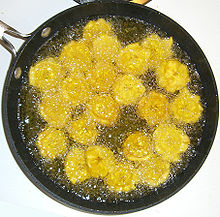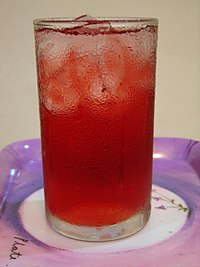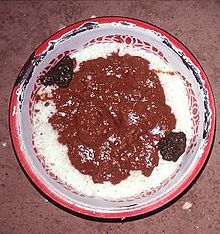
Homemade
meat pie with beef and vegetables

Beef
suya wrapped in plastic
Nigerian cuisine consists of dishes or food items from the hundreds of ethnic groups that comprise the West African nation of
Nigeria. Like other
West African cuisines, it uses
spices and
herbs in conjunction with
palm oil or
groundnut oil to create deeply flavoured sauces and soups often made very hot with
chili peppers.
Nigerian feasts are colourful and lavish, while aromatic market and
roadside snacks cooked on barbecues or fried in oil are plentiful and
varied.
[1]
Entrees
Rice-based
- Coconut rice is a rice dish made with coconut milk.
- Jollof rice is a rice-based food, made up with a range of spices, tomatoes, onions, pepper, meat, oil and a combination of vegetables.
- Pate is made with ground dry corn or rice or acha. Mostly combined with vegetables (spinach), tomatoes, onions, pepper, garden egg, locust beans, groundnut, biscuit bone and meats minces. It is common within northwestern Nigeria, like Kaduna, Nassarawa and Plateau.
- Tuwo masara is corn flour dish eaten also in the northern part of Nigeria.
- Tuwo shinkafa is a thick rice pudding usually eaten with "miyan kuka" (a mucilaginous soup) and goat meat stew or miyan taushe,
a pumpkin stew made with spinach, meat (usually goat or mutton) and
smoked fish. It is primarily served in the northern part of the country.
Bean-based
Meat
Meat is used in most Nigerian dishes.
- Suya is a meat kebab coated with groundnuts (peanuts) and chili pepper and other local spices. It is prepared barbecue style on a stick. This is one of the most famous Nigerian delicacies and can be found within easy reach all over the country.[2]
- Tsire refers specifically to meat which has a generous coating of peanut/ chilli and spice. It may or may not be on a skewer.
- Kilishi,
is made from meat that has been cut into very thin slices which is then
spread out to dry. A special preparation of chilli pepper, spices and
local herbs is then prepared into a paste which is lightly brushed on
both sides. This is then briefly grilled.
- Balangu
refers to meat that has been grilled over wood/ coal fire.
Specifically, no seasoning is applied to bring out the natural flavor of
the particular type of meat which may be goat, sheep or cow meat. Salt
and spices can be added later according to taste.
Soups and stews
- Banga soup is made from palm nuts and is eaten primarily in the midwestern part of Nigeria.
- Miyan kuka is also common among the Hausa people.
- Miyan yakuwa is a famous soup common to the Hausa people.
- Pepper soup
is a light soup made from a mix of meat or fish and a mix of herbs and
spices. This is one of the few soups in Nigerian cuisine that can be
drunk alone and not as a sauce for a carbohydrate main dish such as fufu or pounded yam.[2]
- Afang is a vegetable soup which has its origin from the Efiks in the southeast of Nigeria.
- Corn soup, also known locally as omi ukpoka, is made with ground dry corn and blended with smoked fish. It is common with afemai people mainly from Agenebode in northern Edo state.
- Draw soup (or okoroenyeribe) is made from okro or melon seeds cooked until they thicken.[2]
- Efo riro or tabot stew is a stew made from leafy vegetables and tastes nice when eaten with fish. It is common among the Yorubas.
- Egusi soup is thickened with ground melon seeds and contains leaf vegetables, other vegetables, seasonings, and meat.[2] It is often eaten with dishes like amala, pounded yam (iyan), fufu and more.
- Groundnut stew
with groundnuts (peanuts), tomato and onion as the base, can be
infinitely varied with chicken, beef or fish and different leaf
vegetables for subtle flavours. Groundnut stew is made with ground dry
groundnuts and vegetables, fish, meat, local seasoning and palm oil. It
is common amongst Etsakor people in Edo state.
- Rice Stew, similar to Maafe, is a stew made from goat, beef or chicken and cooked with a tomato, onion, pepper and groundnut sauce.
- Ogbono soup is made with ground ogbono seeds,
with leaf vegetables, other vegetables, seasonings, and meat. Ogbono is
also eaten with many dishes similar to pounded yam, amala, and more.
Side dishes
- Fried plantain (or dodo) is a side dish of plantains fried in vegetable oil or palm oil. It is preferably ripe plantain.[2]
- Funkaso, millet pancakes
- Mosa,
fermented corn, which is ground into a thick paste, fried and then
sprinkled with sugar. It is an acquired taste. There is also an
alternative made from very soft plantain which is mashed into a paste,
mixed with dried black pepper, fried and then sprinkled with sugar, for
those with a sweet tooth.
Puddings, pastes and porridges
- Moimoi is a steamed bean pudding made from a mixture of washed and peeled black-eyed beans and wrapped in a moimoi leaf (like a banana leaf).[2]
Yam-based

A Plate of Pounded Yam (Iyan) and
Egusi Soup.
- Iyan, called pounded yam in English, is similar to mashed potatoes but all mashed and completely smooth with no yam chunks left.[2]
- Amala (or aririguzofranca)
is a thick paste made from yam, which had been peeled, cleaned, dried
and then blended similar to iyan but normally darker (brown) in colour.
Cassava-based
- Eba, also called gari is, like amala, a very thick paste that is either rolled into balls or served like amala, and made from cassava (manioc).[2]
- Fufu
- Lafun
is basically like amala but much lighter in colour, and made from
cassava. It is not to be confused with iyan and tastes and smells
totally different from the yam-based "Iyan".
Breakfast
- Masa is
made from rice which is soaked and then ground. The thick paste is then
poured into clay forms. The clay forms have a heat source from beneath.
A spatula is used to flip it over by gouging it out of the form. It is
traditionally served with miyan taushe.
- Sinasir
is a flat masa, now-a-days simply made by pouring the prepared rice
paste into a frying pan, thus avoiding the need to flip it over as will
be necessary for normal masa.
- Yams and eggs or stew
- Ogi/Akamu
- Bread
Snacks and sweets
- Chin chin is a fried sweet cookie made from wheat flour and eggs and can be made in different shapes and sizes.
- Puff Puff, a fried Nigerian doughnut.
- Akara, similar to the Latin American dish acarajé, is a beignet from a dough based on black-eyed beans. It is sometimes served for breakfast.
- Alkaki, made from wheat and sugar paste
- Kuli-kuli, made from ground peanuts.
- Kokoro is a fried dry snack made from corn and garri (cassava). There are two different kinds.
- Meat pie is a D-shaped pie with beef, potatoes, and optional pepper fillings.
- Sausage roll, meat blanketed with flavored dough.
- Scotch egg
- Wara, soft cottage cheese made from fresh cow milk.
- Plantain chips
- Coconut candy
- Dundun, roasted or deep-fried slices of yam. It may be fried in palm
oil or vegetable oil; water is added to soften the yam as it cooks.
Dundun is usually eaten with a sauce made of groundnut or palm-oil,
tomatoes, chilli peppers and seasoning.[citation needed]
Beverages
Condiments
- Iru is fermented locust beans used as a condiment in cooking and is typically added to egusi soup, ogbono soup, Eyedu, Ila (Okra) and more.
See also
References
External links











No comments:
Post a Comment